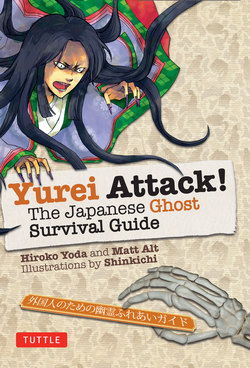Читать книгу Yurei Attack! - Hiroko Yoda - Страница 7
На сайте Литреса книга снята с продажи.
ОглавлениеKNOW YOUR YUREI
Yurei come in many shapes and forms. Yet there are traits and accoutrements common to many of them. Very few if any yurei possess all of these features, but each is strongly indicative of things from beyond the grave. We created this composite illustration to help familiarize you with the basics. Think of it as a “generic Japanese ghost.” The numbers refer to the illustration on the following page.
1. Triangular headdress.
This archaic Buddhist funerary headdress hasn’t been used in actual funerals for generations, but it is a standard prop for yurei.
2. Long, stringy, unkempt hair.
Hair, particularly hair that grows out of control, is a common feature of Japanese ghost stories.
3. Crazed/aggrieved expression.
What, were you expecting a warm smile?
4. Dangling hands.
Don’t let the limp wrists fool you. They aren’t an indication of weakness, but rather a signal that you’re dealing with the dead.
5. White kimono.
The kimono of the dead are folded in the opposite manner of that of living people. (For example, the usual left-over-right lapel style would be right-over-left for a body at a funeral.)
6. Hitodama.
Although literally translated as “human souls,” these weird fireballs are generally considered manifestations of ghostly phenomena rather than actual spirits. They are commonly seen alongside yurei.
7. Lack of feet.
The absence of a physical connection to the ground is a hallmark yurei characteristic.
